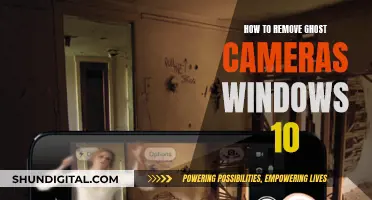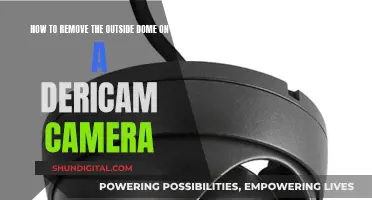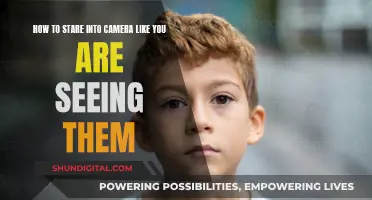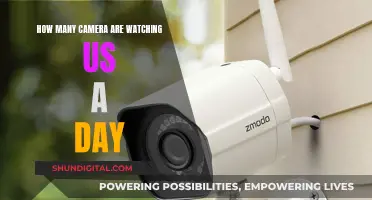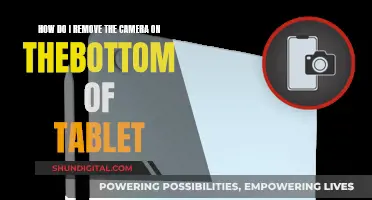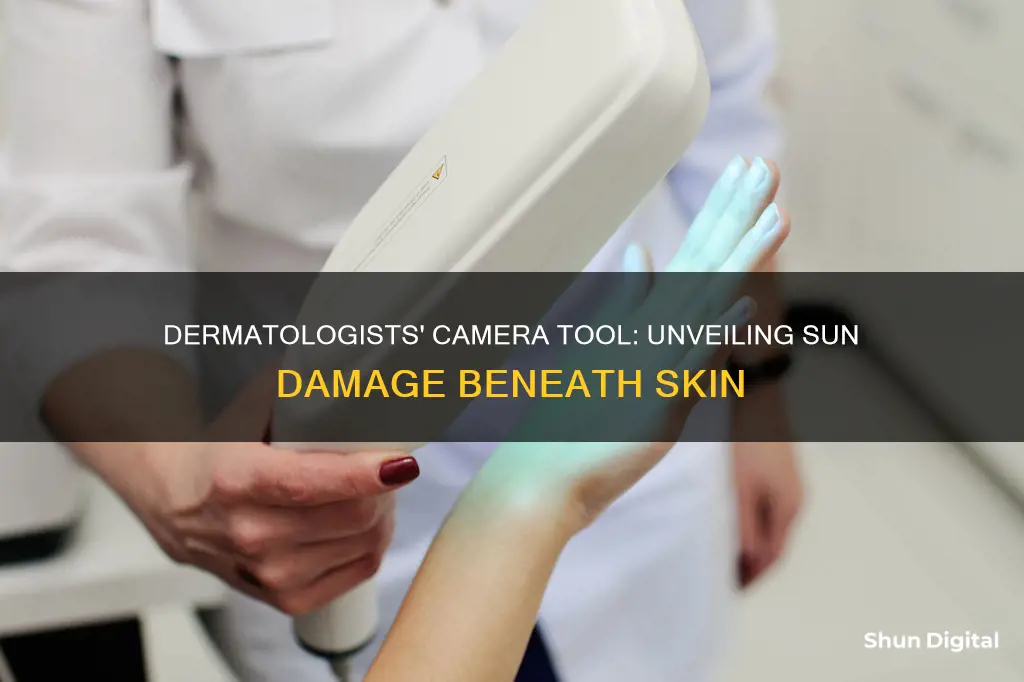
Sun damage to the skin is a serious issue that can lead to premature ageing and skin cancer. Dermatologists refer to sun damage by several names, including photoaging, photodamage, solar damage, and sun damage. This occurs when ultraviolet (UV) light hits the skin unprotected by sunscreen, causing DNA changes at a cellular level. To detect this, dermatologists use a special camera or a regular camera with a filter that catches UV light instead of visible light, exposing damage under the top layer of skin. This technology is growing in popularity among dermatologists, sunscreen brands, and artists.
| Characteristics | Values |
|---|---|
| Camera Type | Ultraviolet (UV) camera |
| Camera Function | Catches UV light instead of visible light |
| Camera Equipment | Special camera or regular camera with a filter |
| Photography Type | UV photography |
| Photography Process | Uses a filter that blocks visible light (but transmits UV light) |
| Photography Process | Long exposures due to a small amount of light getting through to the sensor |
| Photography Process | Removal of the camera's UV-blocking filter |
| Photography Process | Use of a lens that works with UV light |
| Photography Process | Conversion of the camera to UV light |
| Photography Process | Use of a UV-pass filter that only allows UV light to pass through |
| Dermatology Use | To identify sun damage and skin cancer risk |
What You'll Learn
- Cameras that detect sun damage use UV light to expose damage under the top layer of skin
- Dermatologists use UV cameras to encourage better sun protection
- UV cameras can be used to detect signs of photoaging, such as wrinkles and pigmentation changes
- UV photography is a popular trend among young people to scrutinise their bodies and monitor their health
- UV cameras can be used to detect skin cancer

Cameras that detect sun damage use UV light to expose damage under the top layer of skin
Ultraviolet (UV) photography is a technology that has grown in popularity among dermatologists, sunscreen brands, and artists. It involves the use of a special camera or a regular camera with a filter to capture UV light instead of visible light, revealing damage under the top layer of the skin. This type of photography can make bruises, sun spots, freckles, and other pigmentation apparent, even if they are not visible to the naked eye.
UV photography is particularly useful for detecting sun damage because it can show the extent of damage caused by UV light, which is not always visible on the surface of the skin. Sun damage, also known as photoaging, photodamage, or solar damage, occurs when UV light from the sun or tanning beds damages the skin's structure, causing DNA changes at a cellular level. This damage accumulates over time and can lead to premature ageing, wrinkles, loss of skin elasticity, pigmentation changes, sun spots, and even skin cancer.
By using UV cameras, dermatologists can evaluate the extent of sun damage and look for early signs of skin cancer, which is more treatable when detected early. UV photography can also be a powerful tool for patient education, as it provides a visual representation of the damage that UV light can inflict on the skin. Additionally, it can be used by sunscreen brands to demonstrate the importance of sun protection and the effectiveness of their products.
While UV photography equipment used by dermatologists can be expensive, it is possible to achieve similar results with a regular camera and a suitable filter. However, it is important to note that most digital cameras are blind to UV light, and specialised lenses or sensor modifications may be required for effective UV photography.
Candid Camera: Best Places to Watch the Show
You may want to see also

Dermatologists use UV cameras to encourage better sun protection
UV photography has become an increasingly popular way for people to scrutinize their bodies and monitor their health. Some individuals, like ballroom dancer Witney Carson McAllister, a survivor of skin cancer, have shared their UV portraits on social media to advocate for skin protection. These images can be a startling reminder of the importance of sun protection, even when one might think there is no chance of sunburn.
The sun's ultraviolet (UV) rays can have both short-term and long-term effects on the skin. In the short term, one might experience a scorching sunburn. However, the long-term consequences can be more insidious and may not be immediately visible. When the sun prematurely ages the skin, it is referred to as photoaging, which can lead to skin cancer. Photoaging is caused by UV light hitting the skin unprotected by sunscreen, resulting in DNA changes at a cellular level.
Dermatologists have a range of treatments to address photoaging, including lasers, chemical peels, and topical medications. However, sun protection is also essential to prevent, slow down, and even reverse the signs of sun damage. By using broad-spectrum sunscreen with a sun protection factor (SPF) of 50 or higher and reapplying it regularly, individuals can effectively protect their skin from harmful UV rays.
UV cameras serve as a valuable tool for dermatologists to educate their patients about the hidden sun damage that can occur even without noticeable sunburns. By visualizing this damage, individuals are more likely to be motivated to adopt better sun protection habits, reducing their risk of skin cancer and premature aging.
Trail Cameras: How Far Can They See?
You may want to see also

UV cameras can be used to detect signs of photoaging, such as wrinkles and pigmentation changes
UV Cameras for Detecting Photoaging
Ultraviolet (UV) cameras are a popular tool for dermatologists to detect signs of photoaging, which is when the sun prematurely and dangerously ages the skin. Photoaging can lead to skin cancer, so it is important to identify and treat it early.
UV cameras work by capturing UV light instead of visible light, revealing damage beneath the top layer of the skin. This allows dermatologists to see signs of photoaging that are invisible to the naked eye, such as wrinkles and pigmentation changes.
How UV Cameras Work
UV cameras use a special camera or a regular camera with a filter to capture UV light. This light exposes damage under the top layer of the skin, making bruises, sun spots, freckles, and other pigmentation apparent. These cameras can be expensive, but some people have experimented with cheaper methods, such as using a filter that blocks visible light.
Benefits of UV Cameras
UV cameras are useful for early detection of photoaging and skin cancer. They can also be used to educate patients about the importance of sun protection, as the images provide a compelling visualization of the damage that UV rays can cause.
Treatments for Photoaging
While photoaging cannot be completely reversed, there are treatments available to minimize its appearance. These include lasers, chemical peels, topical medications, and photodynamic therapy. These treatments can reduce wrinkles, brown spots, and other signs of sun damage, helping to improve skin texture and tone.
In summary, UV cameras are a valuable tool for dermatologists to detect and treat photoaging caused by sun damage. By revealing hidden signs of aging, UV cameras can help patients understand the importance of sun protection and motivate them to take better care of their skin.
Unblocking Websites: A Camera Chrome Guide
You may want to see also

UV photography is a popular trend among young people to scrutinise their bodies and monitor their health
UV Photography: A Popular Trend Among Young People
Ultraviolet (UV) photography is becoming an increasingly popular trend among young people, particularly those keen to scrutinise their bodies and monitor their health. This type of photography involves the use of a special camera or a regular camera with a filter to capture UV light, revealing damage beneath the top layer of the skin. The resulting images can be startling, with bruises, sun spots, freckles, and other pigmentation issues becoming apparent.
A Powerful Awareness Tool
UV photography is more than just a novelty or an interesting photo to post online. It serves as a powerful tool for raising awareness about sun damage and skin health. Some influencers, like ballroom dancer Witney Carson McAllister, have shared their UV portraits on social media to advocate for skin protection. McAllister, a skin cancer survivor, wanted to show her followers the damage that was invisible to the naked eye.
Detecting Sun Damage
UV photography is a valuable method for detecting sun damage, especially in its early stages. By capturing UV light, these images can reveal hidden sun damage that is not visible to the naked eye. This is important because sun damage can lead to premature ageing, also known as photoaging, and even skin cancer. Dermatologists refer to this damage by several names, including photoaging, photodamage, solar damage, and sun damage.
Signs of Photoaging
Photoaging occurs when ultraviolet light from the sun or tanning beds permanently damages the skin's structure. The signs of photoaging typically begin in the teens to early twenties and can include pigmentation changes such as age spots, loss of skin tone and elasticity, rough and uneven skin texture, broken capillaries, and redness. These changes can make individuals appear older than their peers, and the damage accumulates over time.
Treating and Preventing Photoaging
While photoaging cannot be completely reversed, various treatments can help minimise its appearance. These include lasers, chemical peels, photodynamic therapy, topical medications, and cryotherapy. Additionally, it is crucial to practise good sun protection to prevent future photoaging. Dermatologists recommend using a broad-spectrum sunscreen with an SPF of 50 or higher and reapplying it every two hours or after swimming or exercising.
The Power of UV Photography
UV photography provides a unique perspective on sun damage, allowing individuals to see the hidden effects of UV light on their skin. This technology is not just a trend but a tool for education and empowerment, encouraging young people to take a proactive approach to their skin health and sun protection.
Watching USB Cameras: A Beginner's Guide to Live Viewing
You may want to see also

UV cameras can be used to detect skin cancer
UV Cameras for Skin Cancer Detection
Ultraviolet (UV) cameras can be used to detect skin cancer by revealing sun damage that is invisible to the naked eye. This technology is becoming increasingly popular among dermatologists, sunscreen brands, and even artists.
UV photography works by capturing UV light instead of visible light, thereby exposing damage beneath the top layer of the skin. This includes pigmentation changes such as bruises, sun spots, freckles, age spots, liver spots, and wrinkles.
The use of UV cameras can help dermatologists identify and treat skin cancer in its early stages, when it is most treatable. It is also a valuable tool for patient education, as seeing the extent of their sun damage can motivate people to adopt better sun protection habits.
UV photography requires a special camera or a regular camera with a filter that can capture UV light. Most digital cameras are blind to UV light, so film cameras or cameras with the colour filters on the sensors removed are often used. Additionally, a UV-pass filter that blocks visible light and infrared radiation may be placed in front of the lens.
Benefits of UV Cameras for Skin Cancer Detection
UV cameras can help detect skin cancer by revealing sun damage that may otherwise go unnoticed. This is particularly important as sun damage can lead to skin cancer, and the risk increases with the amount of sun exposure and the degree of skin phototype. By using UV cameras, dermatologists can identify areas of concern and recommend treatment options or preventive measures.
Limitations and Considerations
While UV cameras can be a valuable tool, they should not be solely relied upon for skin cancer detection. It is important to consult a dermatologist for a comprehensive evaluation, as they have the expertise to assess the skin's condition, type, and health before determining the appropriate treatment.
Furthermore, it is worth noting that not all UV cameras are equal, and some may be more effective than others in capturing sun damage. When considering UV photography for skin evaluation, it is essential to seek a qualified dermatologist who uses advanced equipment and has experience in skin cancer detection and treatment.
Switching On: Apple Watch Camera Functionality Explained
You may want to see also
Frequently asked questions
A UV camera or a regular camera with a special filter can be used to capture UV light instead of visible light, revealing sun damage beneath the top layer of skin.
Ultraviolet (UV) light from the sun or tanning beds causes DNA changes at a cellular level, leading to premature aging and an increased risk of skin cancer.
Sun damage can manifest as wrinkles, loss of skin elasticity, pigmentation changes (age spots, freckles), broken capillaries, redness, and uneven skin texture.
It is recommended to use a broad-spectrum sunscreen with an SPF of 50 or higher. Reapply sunscreen every two hours or more frequently if swimming or sweating.
Dermatologists may use various treatments, including lasers, chemical peels, topical medications, and injectables, to reduce the appearance of sun damage and improve skin texture and tone.


